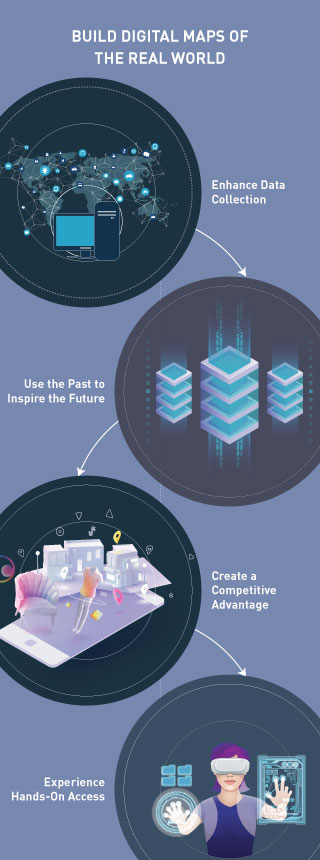From spreadsheets and images to presentations and customer interaction videos, organizations are collecting and storing information only to build bottomless lakes of data. This untapped data is also called as ‘Dark Data.’ Gartner defines dark data as “the information assets organizations collect, process and store during regular business activities, but generally, fail to use for other purposes.” Excavating and utilizing such entombed data holds tremendous potential.
Businesses can reinvent themselves by bridging the gap between data confined to paper and the physical world. Introducing technology that uses physical space such as Spatial Interfaces or Augmented Reality (AR), to project information over real-life objects and places. This will sever to augment peoples’ intelligence and enable them to make better and faster decisions, thus it will not only extend reality, as we know it but will also enable the fast, more efficient accomplishment of tasks and the unmasking of new opportunities.
Why Spatial Interfaces or AR and Why Now?
Humans are wired to think spatially. We find meaning in shapes, sizes, location, and direction, which is why we sometimes find it difficult to understand a flat screen/2D image on paper or device fully. Harnessing the power of data and combining it with artificial intelligence, allows us to project additional information and augment everyday things to make it more understandable.
Valued at around USD 720 million in the year 2016, the global Augmented Reality (AR) in the enterprise market is expected to reach more than USD 30,520 million by 2025, according to the recent report by Zion Market Research. From head-mounted displays to apps in smartphones, enterprises will witness increased adoption of the Internet of Things (IoT) and AR technology.
Integrating digital information with the physical environment, will present hands-free access to data and transform the way enterprises work across a variety of use areas including training, manufacturing, logistics, warehouse operations, and dealer service.
Realizing the Digital Potential of Your Enterprise

To physicalize a connected enterprise ecosystem, businesses can leverage any of the following techniques to reimagine flat designs into engaging spatial experiences:
- Marker-based AR: This typically uses the camera of a smart device and scans a 2D code/image trigger to overlay digital information on a human’s view of the physical world, encouraging your workforce and customers to experience products in an unconventional way.
- Location-based AR: Here the AR content is based on device capabilities such as GPS, gyroscope, accelerometer, and others. It offers navigation support, points places of interest, and can present extra information such as the history or origin of a place.
- Projection-based AR: This technique furnishes your audience with a different visual experience by video projection. By casting images on the surface of 3D objects or space, it allows users to interact with the projected light in a remarkably novel way.
- Superimposition-based AR: Here the real-world view is partially or entirely replaced with digital objects. This resulting, newly created augmented view of an object or space allows users to interact and perform various actions in a virtual space.
Increasing the adoption of technology, sharing data wirelessly and enabling a constant flow of information presents organizations with a new way to incentivize customers and employees in the most relevant manner.
Shaping a New Dimension in User Experience
A recent AR experience that HARMAN Connected Services created was for the Georgia Aquarium. By developing an advanced AR system, they can engage and inspire visitors, all within the palm of their hands. The AR application uses an advanced recognition algorithm that can identify up to 50 animal classes with an accuracy of approximately 90%. This AR animal guide redefines the concept of an aquarium. It has transformed how visitors discover new facts about ocean life, making it more fun and exciting for both young and old.
Providing your workforce with the capability of visualizing information in real-time, helps untangle complex problems and complex data. The dynamic content placed in one’s field of vision makes it easier to perform daily tasks. If presented correctly the AR content will help employees to understand the core issues, or guide them in their decision making. AR can be applied to a vast number of areas, from mobile healthcare diagnostic devices and art installations to virtual hotel room booking applications and manufacturing products.
We have barely begun to scratch the surface of the possibilities of AR technology. It has the potential to enhance live events and places, evoke empathy, eliminate knowledge gaps, increase sales opportunities, reduce data abstraction, transform learning & training and much more. For enterprises seeking to go beyond existing communication tools and workflows, integrating AR into their process and marketing plans will have the first-mover advantage.
Let's explore how you can offer hands-free access to data and empower your workforce and customers. Drop me a line here or on LinkedIn/Twitter.
